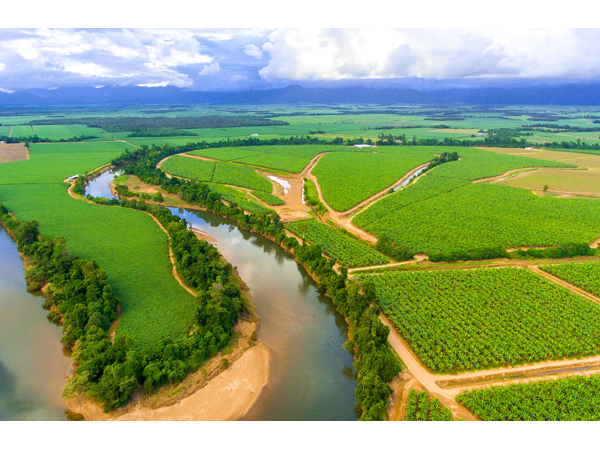Farming communities working together for reef outcomes
By Terrain NRM
Farmers and graziers in Queensland’s north are playing a leading role in designing two groundbreaking projects to improve productivity and reef water quality. The Queensland Government has committed a total of $33 million to fund two Major Integrated Projects (MIPs) in the Wet Tropics and Burdekin regions, led by local natural resource management (NRM) groups Terrain NRM and NQ Dry Tropics.
The Wet Tropics MIP is working with cane and banana farmers in the Far North to reduce nutrient and pesticide losses from farms, while the Burdekin MIP is supporting local landowners to minimise sediment and particulate nutrient runoff into local waterways. Both NRM groups are working alongside a consortia of partner organisations to achieve enduring and sustainable land management improvements within local communities.

An aerial view of the Tully catchment, Far North Queensland.
Wet Tropics MIP
Hundreds of people in the Wet Tropics are helping to steer the course of the reef with a project designed by the community, for the community.
The Wet Tropics MIP project concentrates efforts into the Tully and the South Johnstone catchments, which are identified as hotspots due to their intensive horticulture industries. The project provides an opportunity to achieve a greater impact on water quality using a more localised approach.
While farming practice change is proven as the most cost-effective way of improving water quality, the project proposes a range of other actions in order to meet reef water quality targets.
Terrain NRM CEO Carole Sweatman said the project is an exciting opportunity to make a real difference.
“By working together to pool shared knowledge of the landscapes and circumstances of the basins, people living and working in these areas have created a unique program tailor-made to their environment,” Carole said.
Over the next three years, an implementation phase will operate across a range of scales, covering five key themes including: catchment repair and treatment systems, farm services, local scale monitoring, ‘Our catchment – our community’, and influencing.
Cane grower Alan Colgrave said, “The success of projects that require practice change must involve the landholders first and foremost. To bring about change we must get our farmers involved so they can have confidence and belief in going forward. I’ve never been involved in a project that is so collaborative.”
For more information visit https://terrain.org.au/projects/wet-tropics-major-integrated-project/.

Grazier Bristow Hughes sees the effect of water on dispersive eroded soils.
Burdekin MIP
The Burdekin MIP, known locally as Landholders Driving Change, aims to tackle erosion and improve land management and productivity in the Burdekin region – with graziers getting on board to help design solutions.
Erosion causes valuable topsoil primarily from grazing lands to wash downstream, carrying fine sediment particles that reduce the amount of light needed by coral reefs and seagrass to grow and survive.
The project is targeting the Bowen, Broken, Bogie catchment near Bowen and Collinsville in QLD, which produces almost a quarter of the total fine sediment load delivered to the reef.
Local landholders attended a series of workshops earlier this year to propose ideas and solutions. Then a group of local graziers, scientists, government officers and technical specialists developed and prioritised these ideas into an action plan.
Grazier Bristow Hughes, (Strathalbyn Station, Collinsville), said: “They’re actually asking the landholders what can be done to reduce erosion, rather than having somebody in Brisbane or Canberra tell you how to manage your land.”
Over the next three years the project will trial a mix of new, tried and tested activities that include gully remediation; improving pasture cover; education and training; incentives to support better practices; involving other non-grazing local landholders; and forging closer links between landholders and policy makers. The aim is to develop solutions that could be transferred to other catchments.
Landholders Driving Change is combining graziers’ knowledge with the latest scientific research to improve how the community manages its land for the long term.
For more information, visit http://ldc.nqdrytropics.com.au/



